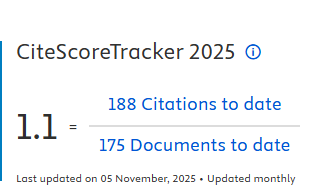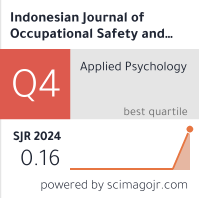Health Risk Assessment of Petrol Filling Workers of West Bengal, India

Downloads
Introduction: In recent decades, rapid urbanization has led to a surge in the number of automobiles on the roads, and consequently, an increase in petrol filling stations. In India, petrol stations are manually operated, and during fuel dispensing workers are routinely exposed to volatile organic compounds (VOCs) and vehicular exhaust. As a result, petrol filling workers face substantial health risks, though their well-being often receives minimal attention. This study aims to assess the adverse effects of VOC exposure on pulmonary function and evaluate associated health risks. Method: A cross-sectional study was conducted among 152 petrol filling workers and 100 control individuals. Spirometry and Peak Expiratory Flow rate tests were performed on both groups along with physical parameters. Respiratory symptoms were recorded via questionnaires. In addition, environmental analysis has been made for total VOCs, benzene, PM2.5 and PM10 and from this analysis carcinogenic and non-carcinogenic risk has been assessed. Results: Pulmonary function parameters were significantly lower in petrol filling workers than in controls. Odds ratios indicate increased risks of respiratory symptoms, including cough, phlegm, and chest tightness, correlated with years of exposure. Workers with over 20 years of exposure reported higher incidences of chronic cough (85%), chronic bronchitis (50%), and chest tightness (35%) compared to those with fewer years of exposure. Carcinogenic and non-carcinogenic risk assessments revealed elevated Lifetime Cancer Risk and Hazard Quotient values. Conclusion: Exposure to benzene, toluene, ethylbenzene, and xylene (BTEX) in petrol and diesel may reduce lung function and elevate the risk of respiratory impairment, alongside heightened carcinogenic and non-carcinogenic health risks.
REFERENCES
Adeniyi, B.O. (2014) ‘Pulmonary function and symptoms among petrol pump attendants in Nigeria’, International Journal of Biological & Medical Research, 5 (1), pp. 3780-84.
Aprajita., Panwar, N.K. and Sharma, R.S. (2011) ‘A study on the lung function tests in petrol pump workers’, Journal of Clinical and Diagnostic Research, 5(5), pp. 1046-50.
Azari, M.R. et al. (2012) ‘Occupational exposure of petroleum depot workers to BTEX compounds’, International Journal of Occupational and Environmental Medicine, 3 (1), pp. 39-44.
Begum, S., Rathna, M.B. (2012) ‘Pulmonary function tests in petrol filling workers in Mysore city’, Pakistan Journal of Physiology, 8(1), pp.12-4. http://www.pps.org.pk/PJP/8-1/Sadiqua.pdf
Benson, C. et al (2021) ‘Assessing the common occupational health hazards and their health risks among oil and gas workers’ Safety Science, 140 (8), pp. 105284. http://dx.doi.org/10.1016/j.ssci.2021.105284
Bhide, A. et al. (2014) ‘Pulmonary function tests in petrol pump workers in Chittoor district’, International Journal of Physiotherapy and Research, 2(1), pp. 354-58.
California Environmental Protection Agency (CalEPA). Toxicity Criteria Database, California Office of Environmental Health Hazard Assessment (OEHHA); 2017.
Chaikleing, S. et al. (2021) ‘Exposure to benzene and toluene of gasoline station workers in Khon Kaen, Thailand and adverse effects’, Human and Ecological Risk Assessment, 27(7), pp.1823-37. http://dx.doi.org/10.1080/10807039.2021.1910010
Chan, C.C., Shie, R.H. and Chang, T.Y. (2006) ‘Workers’ exposures and potential health risk to air toxics in a petrochemical complex assessed by improved methodology’, International Archives of Occupational and Environmental Health, 79 (2), pp. 135-142. https://doi.org/10.1007/s00420-005-0028-9.
Deora, K., Hulke, S.M. and Bhargava, D.C. (2019) ‘Comparison of pulmonary function test in petrol pump worker and auto-rickshaw driver’, Advanced Biomedical Research, 8: 44. https://doi.org/10.4103/abr.abr_204_18
Dhamecha, S. (2021) ‘A study to find out comparative effects of incentive spirometer and nasofilter on pulmonary function among petrol filling workers: An interventional comparative study’, International Journal of Science and Research,10 (9), pp. 1342-47. https://www.ijsr.net/archive/v10i9/SR21924145956.pdf
Edokpolo, B., Yu, QJ. and Connell, D. (2014) “Health risk assessment of ambient air concentrations of Benzene, Toluene and Xylene (BTX) in service station environments”, International Journal of Environmental Research and Public Health, 11, pp 6354-74. http://dx.doi.org/10.3390/ijerph110606354
Egbuonu, A.C.C., Nkwazema, D.C. (2015) ‘Dysfunctional Liver and High Metabolic Organs in Asymptomatic Petroleum Depot Workers in Calabar South-South, Nigeria’, Research Journal of Environmental Sciences, 9 (8), pp. 355-63. http://dx.doi.org/10.3923/rjes.2015.355.363
Egbuonu, A.C.C., Nkwazema, C. and Ezeanyika, L.U. (2015) ‘Cardiovascular Risks and Impaired Lipid Metabolism in Asymptomatic Petroleum Depot Workers in Calabar Metropolis, Nigeria’, Research Journal of Environmental Sciences, 9 (6), pp. 270-79. http://dx.doi.org/10.2139/ssrn.3965466
Jayaraj, S., Shiva, Nagendra, S.M. (2023) ‘Health risk assessment of workers’ exposed to BTEX and PM during refueling in an urban fuel station’ Environmental Monitoring Assessment, 195(12), pp. 1507. https://doi.org/10.1007/s10661-023-12130-8.
Kesavachandran, C. et al. (2006) “Lung function abnormalities among petrol-pump workers of Lucknow, North India”. Current Science, 90 (9), pp 1177-78.
Levsen, K. (1988) “The analysis of diesel particulate”, Fresenius’ Zeitschrift fur analytische Chemie, 331, pp. 467-78. https://doi.org/10.1007/BF00467033
Lerner, J.E.C. et al. (2014) ‘Improvement of health risk factors after reduction of VOC concentrations in industrial and urban areas’, Environmental Science and Pollution Research International, 21 (16), pp. 9676-88. https://doi.org/10.1007/s11356-014-2904-x
Li Z-H, Zhang. et al. (2010) ‘The health risk assessment of groundwater organic pollution at a certain oil depot’, Diqiu Xuebao (Acta Geoscientica Sinica), 31(2), pp. 258-62.
National Ambient Air Quality Status. Central Pollution Control Board, Ministry of Environment & Forests, Government of India, New Delhi 2009
Occupational Safety and Health Administration. OSHA respirator Medical Evaluation Questionnaire. United States Department of Labour. Washington DC, 2010-2012.
Patil, S.V., Patil, S. and Kanitkar, S. (2016) ‘Study of peak expiratory flow rate as the assessment of lung function in occupationally exposed petrol pump workers of Western Maharashtra’, Journal of Krishna Institute of Medical Sciences University, 5(2), pp. 95-100.
Rahimi Moghadam, S. et al (2019) ‘The effect of occupational exposure to petrol on pulmonary function parameters: a review and meta-analysis’, Reviews on Environmental Health, 34(4), pp. 377-90. https://doi.org/10.1515/reveh-2019-0048
Rahimpour, R., Farhadi, S., and Jalali, M. (2017) “Lifetime Cancer Risk and Hazard Quotient of BTXs Compounds in Iranian Petrochemical and Petroleum Depot Workers”, Iranian Journal of Health, Safety & Environment, 5 (2), pp. 982-90.
Ricci, P. (2006) ‘Environmental and health risk assessment and management: principles and practices’, Netherlands. Springer Science & Business Media, 6, pp 370-75.
Shaikh, A., Barot, D. and Chandel, D. (2018) ‘Genotoxic effects of exposure to gasoline fumes on petrol pump workers’, International Journal of Occupational and Environmental Medicine, 9(2), pp.79-87. https://doi.org/10.15171/ijoem.2018.1159
Sharma, N., Gupta, N. and Gupta, R. (2012) Ventilatory impairment in petrol pump workers, JK Science, 14 (1), pp.5-8.
Singhal, M. et al (2007) ‘Pulmonary functions in petrol pump workers: A preliminary study’, Indian Journal of Physiology Pharmacology, 51(3), pp. 244-48. https://www.researchgate.net/publication/5511556.
Sinha, A., Patil, S.N. (2014) ‘Pulmonary function tests in petrol pump workers in Karad Town’, International Journal of Biomedical Research, 5(4). http://dx.doi.org/10.7439/ijbr.v5i4.555.
Solanki, R.B., Bhise, A.R. and Dangi, B.M. (2015) ‘A study on spirometry in petrol pump workers of Ahmedabad, India’, Lung India, 32(4), pp. 347-52. https://doi.org/10.4103/0970-2113.159567
The British Occupational Health Research Foundation (BOHRF) Guidelines for prevention, identification and management of occupational asthma: Evidence review and recommendations. London. 2004
United State Environmental Protection Agency (USEPA). Proposed Guidelines for Carcinogen Risk Assessment. Washington, DC: Office of Research and Development, 1996.
Uzma, N. et al (2008) ‘Impact of organic solvents and environmental pollutants on the physiological function in petrol filling workers’, International Journal of Environmental Research and Public Health, 5(3), pp. 139-46. https://doi.org/10.3390/ijerph5030139
Wang, S. et al. (2017) ‘The effects of body mass index on spirometry tests among adults in Xián, China’, Medicine, 96 (15), pp. 13-16. https://doi.org/10.1097/md.0000000000006596
Wulandari, D.A., Tarigan, L. and Lubis, H.S. (2014) ‘Karakteristik danKapasitas Vital Paksa Paru Pekerja Bagian Produski Aspal Hotmix PT. Sabaritha Perkasa Abadi Tahun’, Jurnal Lingkungan Dan Keselamatan Kerja.
Zafar, M. (2016) ‘Correlation of respiratory symptoms and spirometric lung pattern among petrol pump workers Karachi, Pakistan: Cross-sectional survey’, International Journal of Health System and Disaster Management, 4, pp. 36-40. https://doi.org/10.4103/2347-9019.175670

This work is licensed under a Creative Commons Attribution-NonCommercial-ShareAlike 4.0 International License.

In order to be accepted and published by The Indonesian Journal of Occupational Safety and Health, Author(s) who submit an article should complete all the review process. The copyright of received articles assigned to the The Indonesian Journal of Occupational Safety and Health and Department of Safety and Health, Universitas Airlangga as publishers of the journal. The intended copyright includes the rights to publish articles in various forms (including reprints).
The Editorial Team of The Indonesian Journal Of Occupational Safety and Health and Department of Safety and Health strive to ensure that no errors occur in the articles that have been published, both data errors and statements in the article.
Users of this website will be licensed to use materials from this website following the Creative Commons Attribution-NonCommercial-ShareAlike 4.0 International License. No fees charged. Please use the materials accordingly.
------------------------------------------------------------------------------------------------------------------------------------------------------------------------------------------
Attribution ” You must give appropriate credit, provide a link to the license, and indicate if changes were made. You may do so in any reasonable manner, but not in any way that suggests the licensor endorses you or your use.
NonCommercial ” You may not use the material for commercial purposes.
ShareAlike ” If you remix, transform, or build upon the material, you must distribute your contributions under the same license as the original.







 How to Submit Articles in OJS
How to Submit Articles in OJS

























